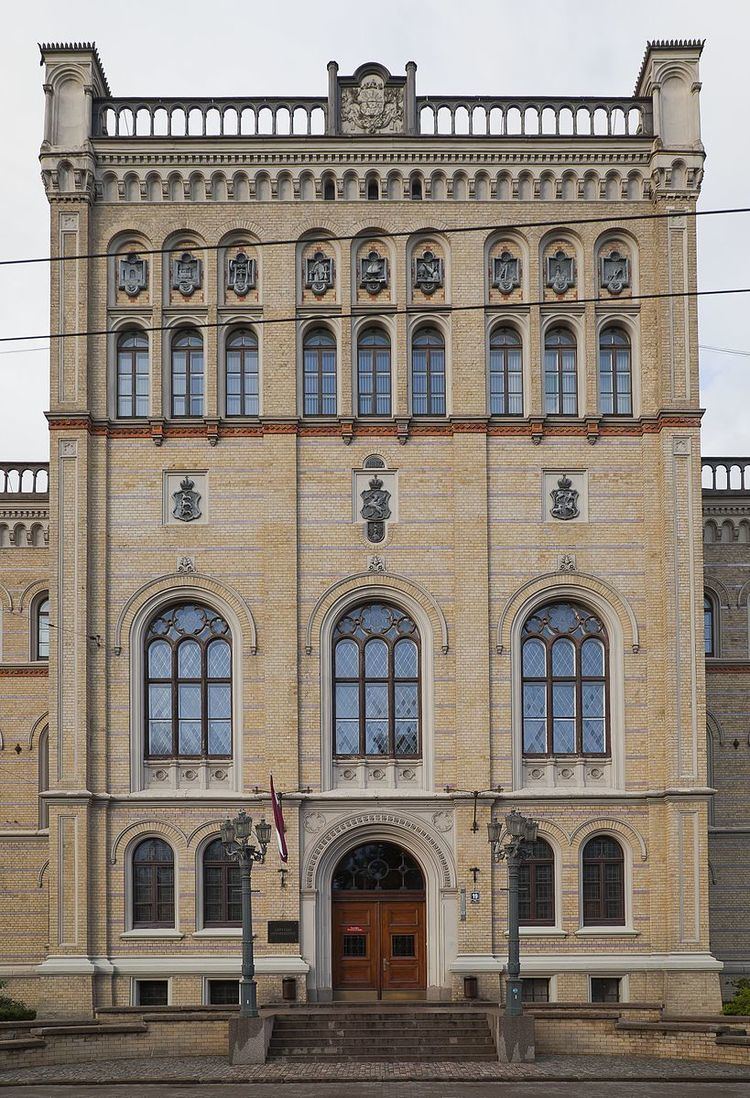Type Public Students 14,020 (2014) Postgraduates 3536 (2014) Total enrollment 19,095 (2011) Founded 1919 | Established 1919 Undergraduates 9,680 (2014) Doctoral students 804 (2014) Phone +371 67 034 444 Rector Indriķis Muižnieks | |
 | ||
Motto Scientiae et patriae (For science and fatherland) Affiliations European University Foundation - Campus Europae, Utrecht Network, European University Association Notable alumni Similar Riga Technical University, Riga Stradiņš University, Latvia University of Agricult, Riga Teacher Training, Turība University Profiles | ||
P stradins medical college of the university of latvia
The University of Latvia (LU) (Latvian: Latvijas Universitāte) is a state-run university located in Riga, Latvia. It was established in 1919.
Contents
- P stradins medical college of the university of latvia
- Study in latvia study in university of latvia
- History
- Enrollment
- Organisation
- Institute of Mathematics and Computer Science
- Amateur Art Activities
- Notable professors and lecturers
- Notable alumni
- References
The university is ranked 701st–750th in the world, as well as 4th in the Baltic states after the University of Tartu, Tallinn University of Technology, and Vilnius University.
Study in latvia study in university of latvia
History
The University of Latvia, named at that time "Higher School of Latvia" (Latvian: Latvijas Augstskola) was founded on September 28, 1919 on the basis of the former Riga Polytechnic (founded in 1862). The first rector of the university was chemist Paul Walden. In 1923, this school received its now resumed name – the University of Latvia (Universitas Latviensis).
In the period between 1919 and 1940, the University of Latvia was the greatest center of higher education, science and culture in Latvia. The former building of the Riga Polytechnic on Raiņa bulvāris 19 serves as the university's main building.
In the pre-war years, it was possible to gain higher academic education not only at the University of Latvia, but also at the Latvian State Conservatory and Academy of Arts. Over time, the Latvian University of Agriculture, Riga Stradiņš University, and Riga Technical University separated from the University of Latvia and became well-known centers of education and research in their own right.
With Latvia regaining independence, the Supreme Council of the Republic of Latvia reconfirmed the Constitution of the University of Latvia on September 18, 1991. It stated that the Higher School is "a state establishment of academic education, science and culture which serves the needs of Latvia and people". Alongside the Constitution, the flag, the hymn, the University's emblem, the Rector's chain, and the official garments for the Rector, Vice-Rector and deans were renewed as attributes of the University of Latvia.
The EuroFaculty, created by the CBSS to support reforms at the universities in Tartu, Riga, and Vilnius, was organized with its headquarters at the University of Latvia, 1993–2005.
Enrollment
The University of Latvia offers undergraduate, graduate, and doctoral levels of study and in October 2014 more than 14,000 students, including PhD and exchange students, had enrolled in various study programs. Almost one third of them studied in business and economics related programs.
Organisation
The university consists of 13 faculties:
- Faculty of Biology;
- Faculty of Chemistry;
- Faculty of Physics and Mathematics;
- Faculty of Business, Economics and Management;
- Faculty of Education, Psychology and Arts;
- Faculty of Geography and Earth sciences;
- Faculty of History and Philosophy;
- Faculty of Law;
- Faculty of Medicine;
- Faculty of Humanities;
- Faculty of Social sciences;
- Faculty of Theology;
- Faculty of Computing.
In addition to the university's various faculties and its medical wing, the Riga Medical College (Rīgas Medicīnas koledža), the University of Latvia offers most of the resources traditionally associated with accredited universities, including several libraries, research facilities, study centers, a language school, and a career center.
Institute of Mathematics and Computer Science
The Institute of Mathematics and Computer Science (IMCS) was founded in 1959 as a computer research centre, now consisting of about 200 researchers, assistants, engineers, and software developers.
Amateur Art Activities
The university has a number of amateur choirs, orchestras and dance groups, as well as a student theater.
